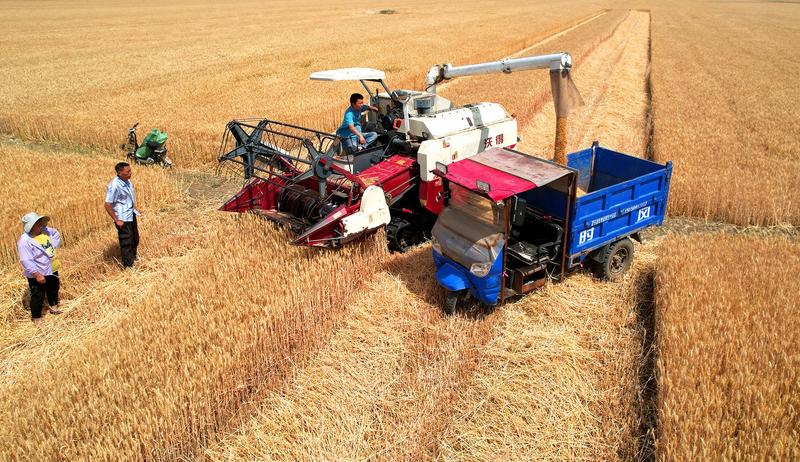 Farmers rotate harvested wheat for drying in Lujiang, Anhui province, last month. (ZUO XUEZHANG / FOR CHINA DAILY)
Farmers rotate harvested wheat for drying in Lujiang, Anhui province, last month. (ZUO XUEZHANG / FOR CHINA DAILY)
China is expected to see another bumper grain harvest as machine harvesting proceeds across the nation, the Ministry of Agriculture and Rural Affairs said recently.
As of Saturday, 2.53 million hectares of winter wheat have been harvested across the country, with daily capacity of 452,000 hectares. The provinces of Sichuan and Hubei are in the final stage of harvesting, Henan and Anhui have made 10 percent progress, and others have gradually started to harvest, the ministry said.
Large-scale machine harvesting indicates wheat production has increased in major grain producing areas.
The winter grain harvest is the first season of the annual grain output. At present, 97 percent of winter wheat nationwide needs to be harvested by agricultural machinery, according to the ministry's department of agricultural mechanization.
China has over 600,000 wheat harvesters, which basically meet the demand for the machinery required.
To ensure grain production remains within COVID-19 containment measures, the ministry has cooperated with health and transportation authorities to ensure a smooth harvest.
More than 2,600 green channels have been opened for transporting agricultural machinery to speed up the process.
Authorities have set up parking sites with necessary refueling and maintenance services to facilitate cross-regional operations.
The ministry on Saturday dispatched nine working groups to guide machine harvesting in provinces including Henan, Anhui and Jiangsu.
 Farmers reap wheat with a harvester in Guannan, Jiangsu province, on Tuesday. (GENG YUHE / FOR CHINA DAILY)
Farmers reap wheat with a harvester in Guannan, Jiangsu province, on Tuesday. (GENG YUHE / FOR CHINA DAILY)
The average loss rate of the wheat harvest is expected to be kept under 2 percent, it said.
Eight major wheat-producing areas, including Henan, which was hit hard by floods last year, have established 5,400 rescue teams to handle emergencies caused by possible disastrous weather.
Affected by the autumn floods last year, five provinces in China had planted 7.3 million hectares of late-sown wheat, and experienced terrible conditions for seedlings.
The central government invested 6 billion yuan ($900 million) to ensure a stable and bumper harvest of grain while agricultural and rural departments at all levels continued to provide technical support to increase production, which resulted in the better-than-expected grain growth.
Zhu Enlin, deputy director of the department of crop production, said good field management guided by agricultural technicians has helped weak wheat grow stronger.
"Spraying foliar fertilizers, pesticides and plant growth regulators are among the key measures to increase production during the final growing phase of wheat, which alleviated the negative effects of late-sown wheat," he said.
The prevention and control of diseases such as stripe rust and scab also contributed to the better growth of wheat, he added.
Guo Jinkao, a consultant of the ministry's expert team guiding wheat production, said effective spraying can increase wheat production by at least 10 percent, which means a 750-kilogram increase per hectare farmed.
Plant protection authorities have been providing services despite the impact of the epidemic.
Drones from 32,000 organizations completed the spraying of 20.6 million hectares of land, effectively helping wheat kernels grow bigger and positively contributing to the summer harvest, according to the ministry.


